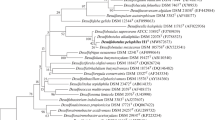Abstract
A new Desulfovibrio strain ThAc01 was isolated from freshwater mud; the strain conserved energy for growth under strictly anaerobic conditions by disproportionation of thiosulfate or sulfite to sulfate and sulfide according to the following reactions:
Strain ThAc01 required acetate as a carbon source, but was unable to utilize acetate as an oxidizable energy source. In a defined medium with acetate and bicarbonate as carbon sources, the growth yields per mol of substrate disproportionated were 2.1 g or 3.2 g dry cell mass on thiosulfate or sulfite, respectively. Strain ThAc01 was also able to grow by dissimilatory sulfate reduction with lactate, ethanol, propanol, or butanol as electron donors and carbon sources which were incompletely oxidized to the corresponding fatty acids. However, growth by sulfate reduction was slower than by disproportionation. Elemental sulfur, nitrate, fumarate, or malate did not serve as electron acceptors. Strain ThAc01 contained desulfoviridin and cytochromes; it required panthothenate and biotin as growth factors and had a DNA base ratio of 64.1 mol% G+C. Disproportionating bacteria similar to strain ThAc01 were enriched with either thiosulfate or sulfite from various freshwater, brackish or marine mud samples. Most probable number enumeration indicated that 2×106 thiosulfate-disproportionating bacteria were present per ml freshwater mud. Of various other sulfate-reducing bacteria tested, only Desulfobacter curvatus (strain AcRM3) was able to disproportionate thiosulfate or sulfite. Desulfovibrio vulgaris (strain Marburg) slowly disproportionated sulfite, but effected only a slight increase in cell density. Strain ThAc01 is proposed as the type strain of a new species, Desulfovibrio sulfodismutans.
Similar content being viewed by others
References
Almgren T, Hagström I (1974) The oxidation rate of sulphide in sea water. Water Res 8:395–400
Broda E (1975) The evolution of the bioenergetic process. Pergamon Press, Oxford New York
Chen KY, Morris JC (1972) Oxidation of sulfide by O2: catalysis and inhibition. J Sanit Engin Div 98:215–227
Cline E (1969) Spectrophotometric determination of hydrogensulfide in natural waters. Limnol Oceanogr 14:454–458
Cline JD, Richards FA (1969) Oxygenation of hydrogen sulfide in seawater at constant salinity, temperature, and pH. Environ Sci Technol 3:838–843
Flossdorf J (1983) A rapid method for the determination of the base composition of bacterial DNA. J Microbiol Methods 1:305–311
Goldhaber MB, Kaplan IR (1974) The sulfur cycle. In: Goldberg ED (ed) The sea, vol 5. Wiley, New York, pp 569–655
Jørgensen BB, Kuenen JG, Cohen Y (1979) Microbial transformations of sulfur compounds in a stratified lake (Solar Lake, Sinai). Limnol Oceanogr 24:799–822
Jørgensen BB (1982) Ecology of sulphur bacteria. Phil Trans R Soc Lond B 298:543–561
Kelly PD (1982) Biochemistry of chemolithotrophic oxidation of inorganic sulphur. Phil Trans R Soc Lond B 298:499–528
Luther GW, Church IM, Sundlark JR, Cosman M (1986) Inorganic and organic sulfur cycling in salt-marsh pore waters. Science 232:746–749
Nor YM, Tabatabai MA (1975) Colorimetric determination of microgram quantities of thiosulfate and tetrathionate. Anal Lett 8:537–547
Pachmayr F (1960) Vorkommen und Bestimmung von Schwefelverbindungen in Mineralwasser. PhDthesis, University München
Peck HD, Le Gall J (1982) Biochemistry of dissimilatory sulphate reduction. Phil Trans R Soc Lond B 298:443–466
Pfennig N, Widdel F (1982) The bacteria of the sulphur cycle. Phil Trans R Soc Lond B 298:433–441
Postgate JR (1959) A diagnostic reaction of Desulphovibrio desulphuricans. Nature 183:481–482
Postgate JR (1984) The sulfate-reducing bacteria, 2nd edn. Cambridge University Press, Cambridge London New York
Schidlowski M (1979) Antiquity and evolutionary status of bacterial sulfate reduction: sulfur isotope evidence. Orig Life 9:299–311
Schmidt M (1984) Chemical problems of flue-gas desulfurisation. In: Müller A, Krebs B (eds) Sulfur, studies in inorganic chemistry, vol 5. Elsevier, Amsterdam, pp 259–275
Skyring GW, Donnelly TH (1982) Precambrian sulfur isotopes and a possible role for sulfite in the evolution of biological sulfate reduction. Precambrian Res 17:41–61
Sorokin YI (1970) Interrelations between sulphur and carbon turnover in meromictic lakes. Arch Hydrobiol 66:391–446
Tabatabai MA (1974) Determination of sulphate in water samples. Sulphur Inst J 10:11–13
Trüper HG, Fischer U (1982) Anaerobic oxidation of sulfur compounds as electron donors for bacterial photosynthesis. Phil Trans R Soc Lond B 298:529–542
Widdel F (1987) Microbiology and ecology of sulfate- and sulfurreducing bacteria. In: Zehnder AJB (ed) Environmental microbiology of anaerobes, chapter 10. John Wiley, New York London (in press)
Widdel F, Pfennig N (1981) Studies on dissimilatory sulfate-reducing bacteria that decompose fatty acids. I. Isolation of new sulfate-reducing bacteria enriched with acetate from saline environments. Description of Desulfobacter postgatei gen. nov., sp. nov. Arch Microbiol 129:395–400
Widdel F, Pfennig N (1984) Dissimilatory sulfate- or sulfur-reducing bacteria. In: Krieg NR, Holt JG (eds) Bergey's manual of systematic bacteriology, IX. edn, vol I. Williams & Wilkins, Baltimore London, pp 663–679
Author information
Authors and Affiliations
Additional information
Dedicated to Professor John R. Postgate on the occasion of his 65th birthday
Rights and permissions
About this article
Cite this article
Bak, F., Pfennig, N. Chemolithotrophic growth of Desulfovibrio sulfodismutans sp. nov. by disproportionation of inorganic sulfur compounds. Arch. Microbiol. 147, 184–189 (1987). https://doi.org/10.1007/BF00415282
Received:
Accepted:
Issue Date:
DOI: https://doi.org/10.1007/BF00415282




